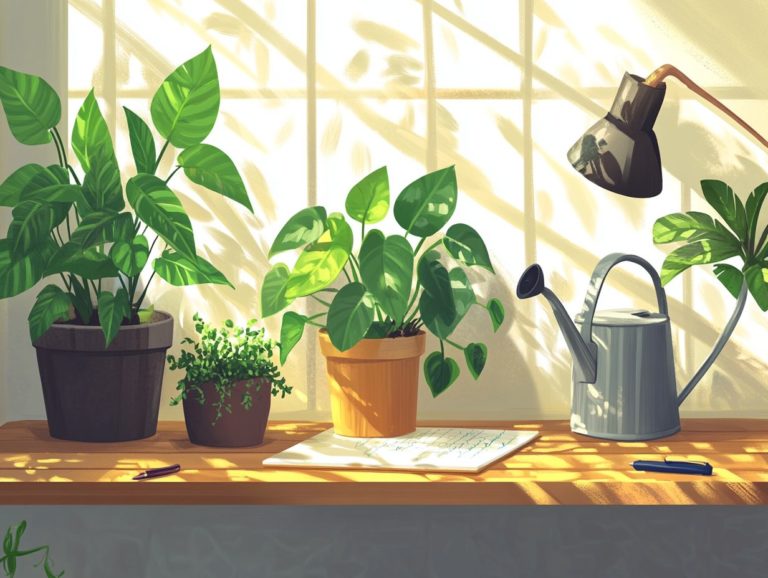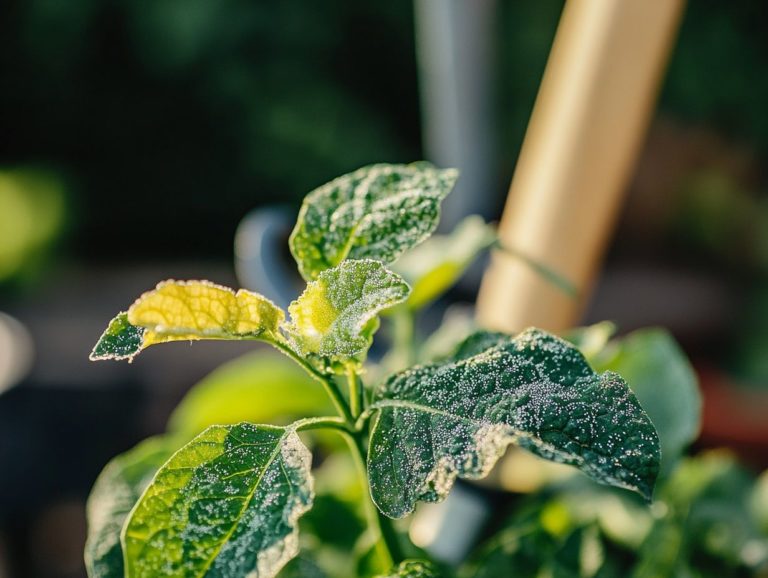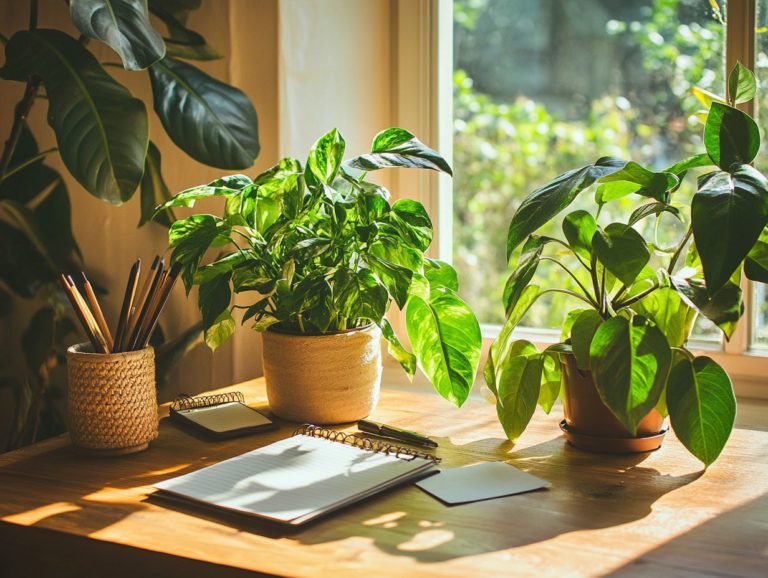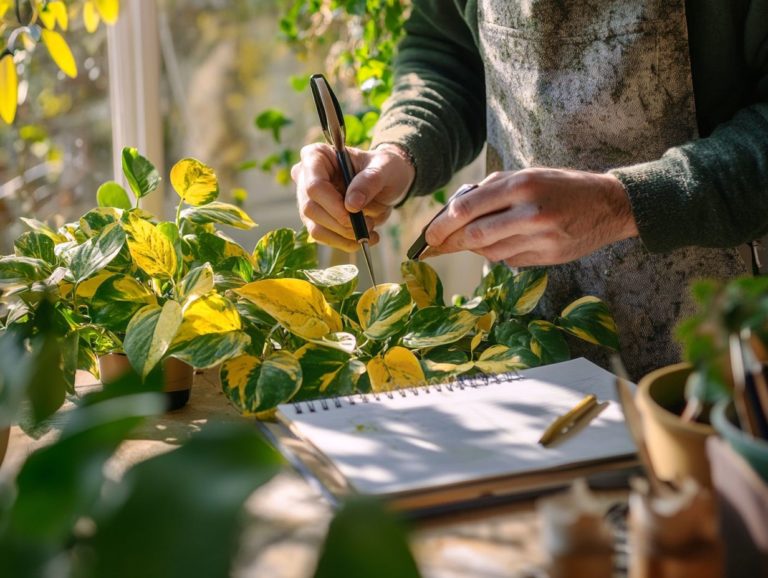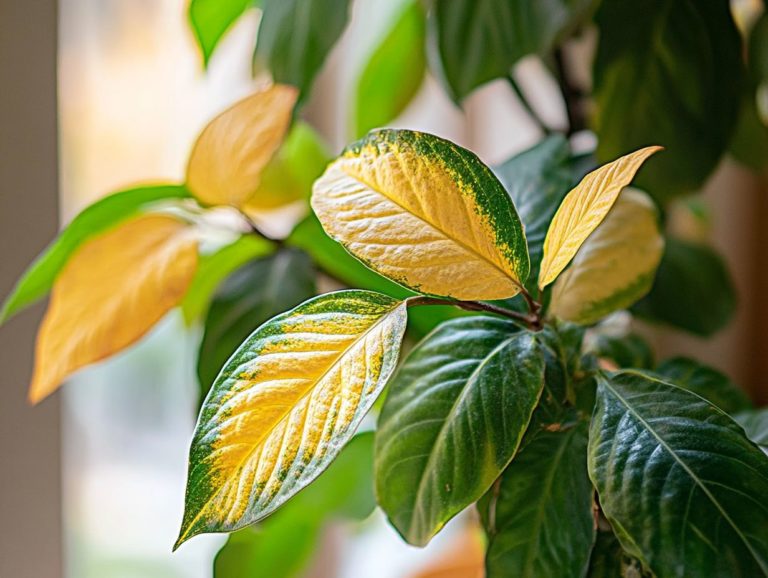Top 5 Indoor Plant Diseases to Watch For
Indoor plants bring your home to life and enhance its beauty, yet they are not immune to various diseases that can threaten their health and vibrancy.
From pesky mealybugs to troublesome fungal issues like powdery mildew, understanding these common ailments is crucial for any dedicated plant enthusiast.
Let s dive into the top five indoor plant diseases you need to know about, detailing their causes, symptoms, and effective prevention and treatment strategies. Immerse yourself in this knowledge to ensure your green companions continue to thrive!
Contents
- Key Takeaways:
- 1. Powdery Mildew
- 2. Root Rot
- 3. Leaf Spot
- 4. Mealybugs
- 5. Spider Mites
- What Causes Indoor Plant Diseases?
- Frequently Asked Questions
- What are the top 5 indoor plant diseases to watch for?
- How can I identify powdery mildew on my indoor plants?
- What causes root rot in indoor plants?
- Can leaf spot spread to other plants?
- How do I get rid of spider mites on my indoor plants?
- Are there any preventative measures I can take to avoid fungal infections on my indoor plants?
Key Takeaways:
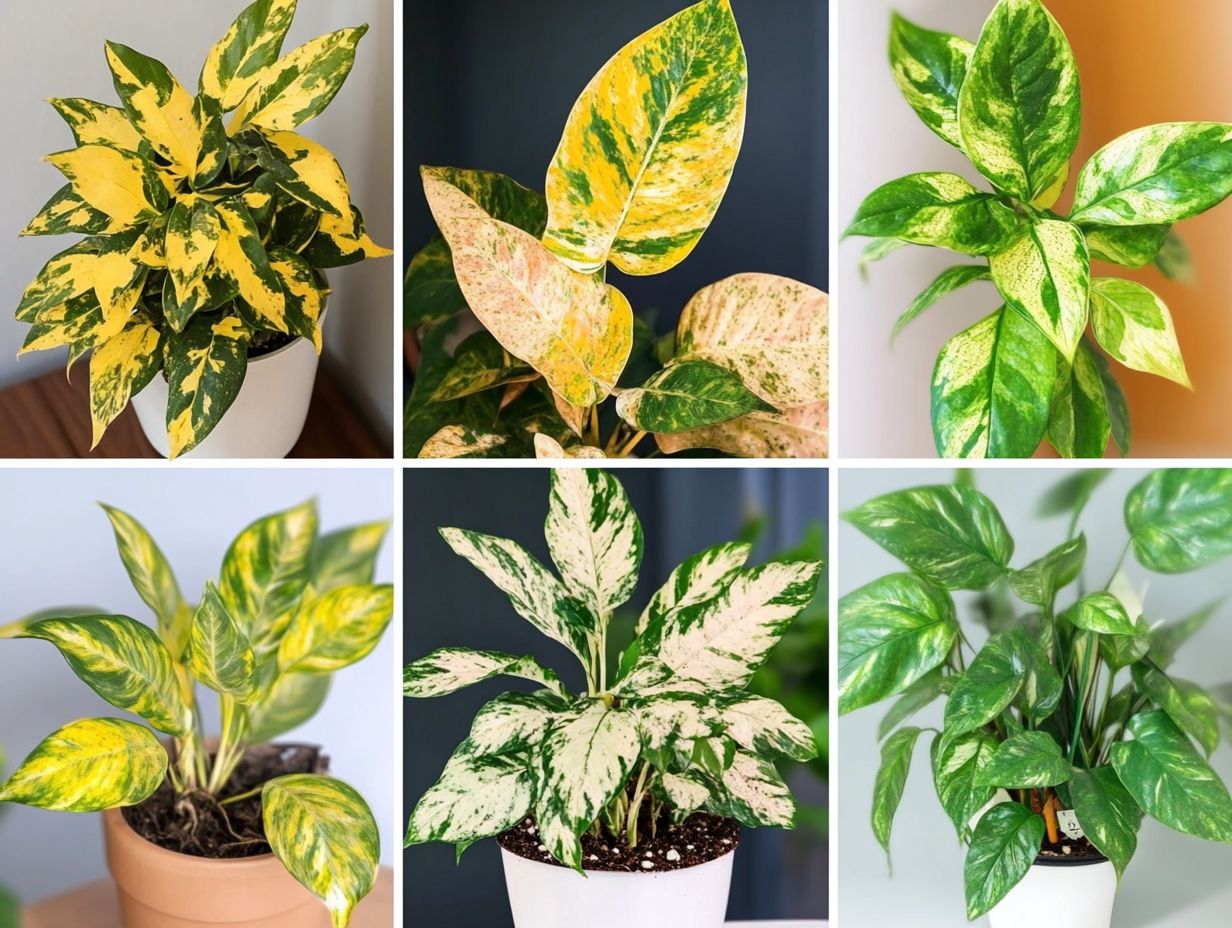
Regularly check for signs of powdery mildew on indoor plants, such as white powdery spots on leaves, and take immediate action to prevent its spread.
Prevent root rot by avoiding overwatering and ensuring proper drainage for indoor plants.
Keep an eye out for leaf spots, which may indicate a fungal or bacterial infection, and take steps to control the spread of the disease.
1. Powdery Mildew
Powdery mildew is a common plant disease that appears as white, powdery spots on leaves. If you notice this, it often signals high humidity levels and poor air circulation, which can lead to serious issues for your houseplants if not addressed promptly.
This fungal infection frequently affects indoor plants, including varieties like Ficus, and is marked by a sticky residue that can hinder growth and vitality.
The conditions that favor powdery mildew usually include warm temperatures and insufficient light, creating an ideal environment for the fungus to thrive. This challenge disrupts photosynthesis and weakens your plants, making them more susceptible to pest invasions.
To tackle this issue, consider using neem oil as an effective organic treatment; synthetic fungicides can also offer a robust solution. Incorporating preventative measures like ensuring adequate air circulation and placing your plants in well-lit areas can significantly reduce the risk of outbreaks and promote a flourishing indoor gardening experience.
2. Root Rot
Root rot is a serious concern that often arises from overwatering, which can damage roots and lead to unhealthy plants. You ll notice common symptoms like yellowing leaves, distorted growth, and leaf drop, all signaling that urgent care is needed for your greenery.
This condition impairs a plant’s ability to absorb nutrients and water effectively. A primary cause of root rot is improper soil moisture levels, influenced by factors such as poor drainage or inadequate potting mixes.
To protect against root rot, ensure that your soil can drain excess water, avoiding those dreaded waterlogged conditions. Regularly adjusting your watering schedule according to seasonal changes and the specific needs of your plants is key to maintaining optimal moisture levels.
If you find yourself dealing with existing damage, repotting your plants into fresh, well-draining soil can make a world of difference, promoting healthier growth and revitalizing your green companions.
3. Leaf Spot
Leaf spot is a common symptom of various plant diseases, marked by dark, water-soaked spots on leaves. You ll often notice these issues arising in high humidity and poor air circulation, especially in indoor environments, which can signal underlying problems with your houseplants.
These unsightly blemishes can stem from a multitude of factors, including fungus problems, bacterial pathogens, and environmental stresses. For example, overwatering or persistently damp conditions can create a perfect breeding ground for fungi, leading to different types of leaf spots caused by culprits like Cercospora or Alternaria. Inconsistent watering practices can weaken your plants, making them more vulnerable to diseases.
Maintaining optimal humidity levels is essential; too much moisture can invite unwelcome pathogens, while too little can stress your plants. To combat these issues, consider implementing the following treatment strategies:
- Remove affected leaves
- Ensure proper drainage
- Apply fungicides or bactericides as needed
Regular monitoring and appropriate care are vital in preventing the spread of these problems, ensuring your plants thrive in their environment.
Have you dealt with any of these issues? Share your tips below!
4. Mealybugs
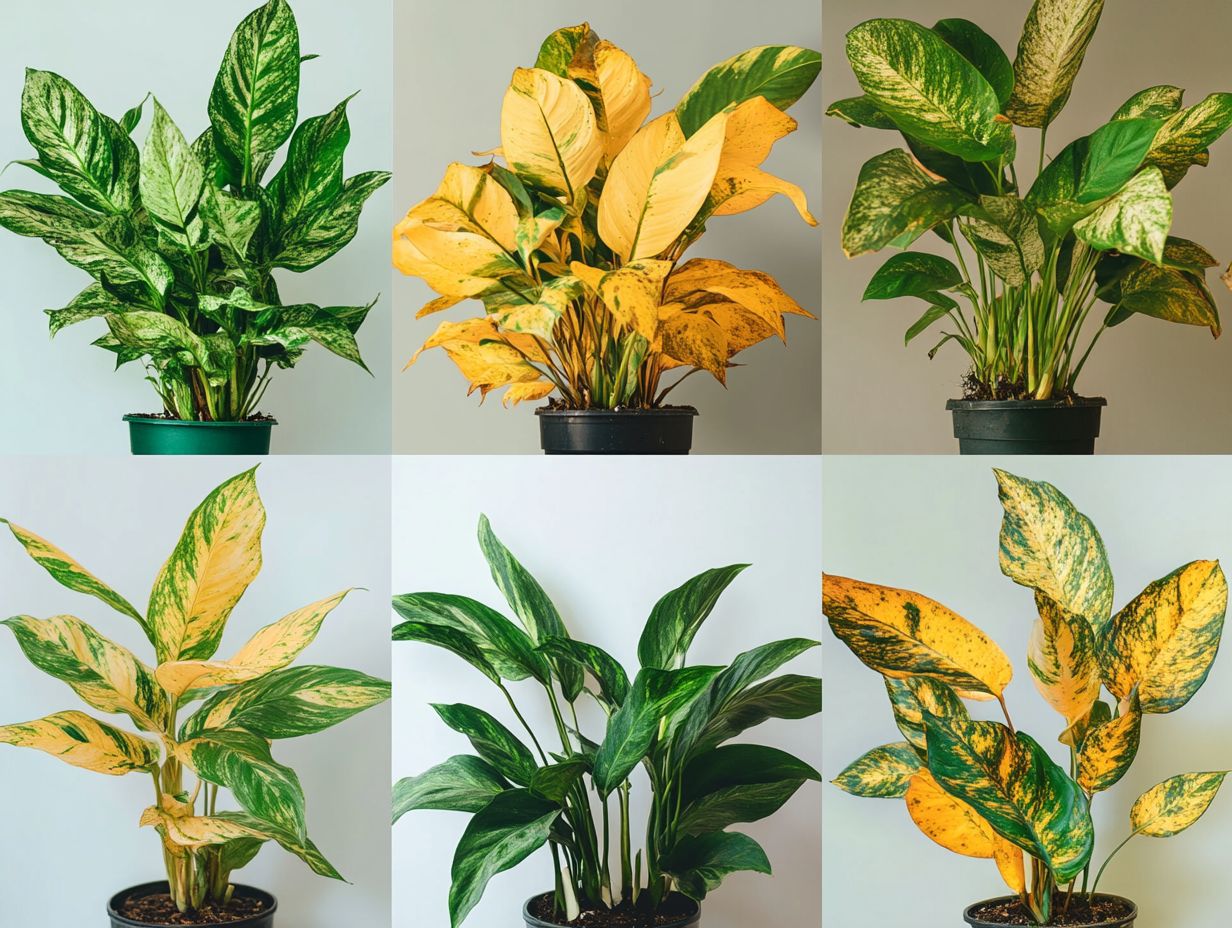
You can easily identify them by their cotton-like appearance and the sticky residue they leave behind. This residue can cause significant problems for your indoor greenery if not addressed promptly, ultimately leading to unhealthy plants.
These tiny insects flourish in warm, humid conditions and reproduce at an alarming rate. This often results in large infestations that drain the vitality of the plants they invade. The reproductive cycle of mealybugs is particularly alarming, with females laying hundreds of eggs that quickly hatch into nymphs, spreading their little army to other parts of the plant.
You might notice signs of a mealybug invasion, such as yellowing leaves, stunted growth, and that sticky substance known as honeydew. This substance can attract even more unwelcome guests like ants. To combat these invaders, many home gardeners turn to neem oil, an organic pesticide that disrupts the mealybugs’ life cycle while remaining safe for your plants.
Other effective treatments include:
- Regularly wiping the affected areas with a cotton swab dipped in rubbing alcohol.
- Introducing natural predators like ladybugs to help keep the pest population in check.
5. Spider Mites
Spider mites are notorious for turning your indoor plants into their personal buffet. This leads to some not-so-great symptoms like distorted growth, yellowing leaf tips, and a general decline in plant health if you don t act quickly. This underscores the importance of vigilant plant care.
These tiny pests love to invade warm, dry conditions, so you must keep a close watch on humidity levels and ensure proper air circulation around your plants. Their feeding habits involve piercing and extracting sap from plant tissues, which weakens the plants and can also result in fine webbing as the infestation takes hold.
To fend off these unwelcome guests, make it a habit to regularly inspect your plants and maintain a consistently humid environment. If you face an infestation, treatments like insecticidal soaps, which kill pests on contact, or neem oil can effectively disrupt their life cycle and help your affected houseplants bounce back.
What Causes Indoor Plant Diseases?
Indoor plant diseases can arise from many factors, including environmental stressors like excessive humidity, insufficient light, overwatering, and pest infestations. If unmanaged, these issues cause symptoms such as yellowing leaves and distorted growth.
These problems often stem from the delicate balance that every indoor plant requires. They can be further complicated by pesky invaders like gnats and spider mites. For example, gnats thrive in overly damp conditions, while spider mites prefer the dry side of life. This illustrates just how crucial humidity and moisture levels are for your plants’ well-being. Being aware of the top signs of indoor plant distress can help you maintain their health.
Recognizing early signs of stress, such as wilting or discoloration, is essential for timely intervention. By implementing preventive measures like rotating pots for even light exposure, fine-tuning your watering schedule, and opting for natural pest control solutions, you can significantly bolster your plants’ health and vitality. Additionally, consider incorporating the top 5 indoor plants that bloom to enhance your indoor environment.
How Can These Diseases Be Prevented?
Preventing indoor plant diseases requires a variety of strategies. You’ll want to maintain optimal humidity levels, ensure proper light exposure, and adhere to regular plant care routines. All these factors contribute significantly to the overall health and resilience of your houseplants against potential threats.
Keeping a close eye on environmental conditions can truly make a difference in preventing disease outbreaks. Use a hygrometer, a tool to measure humidity, to monitor levels and adjust as needed, promoting a balanced atmosphere for your plants.
Employing proper watering techniques is crucial. Overwatering can lead to root rot and fungal issues. Always let the soil dry out a bit between waterings to keep your plants thriving!
Consider using neem oil as a preventive treatment against pests. This not only protects your plants but also ensures a healthier growing environment without the use of harsh chemicals. This approach fosters a more vibrant and thriving indoor garden.
With these tips, your indoor garden will flourish start today!
What Are the Symptoms of These Diseases?
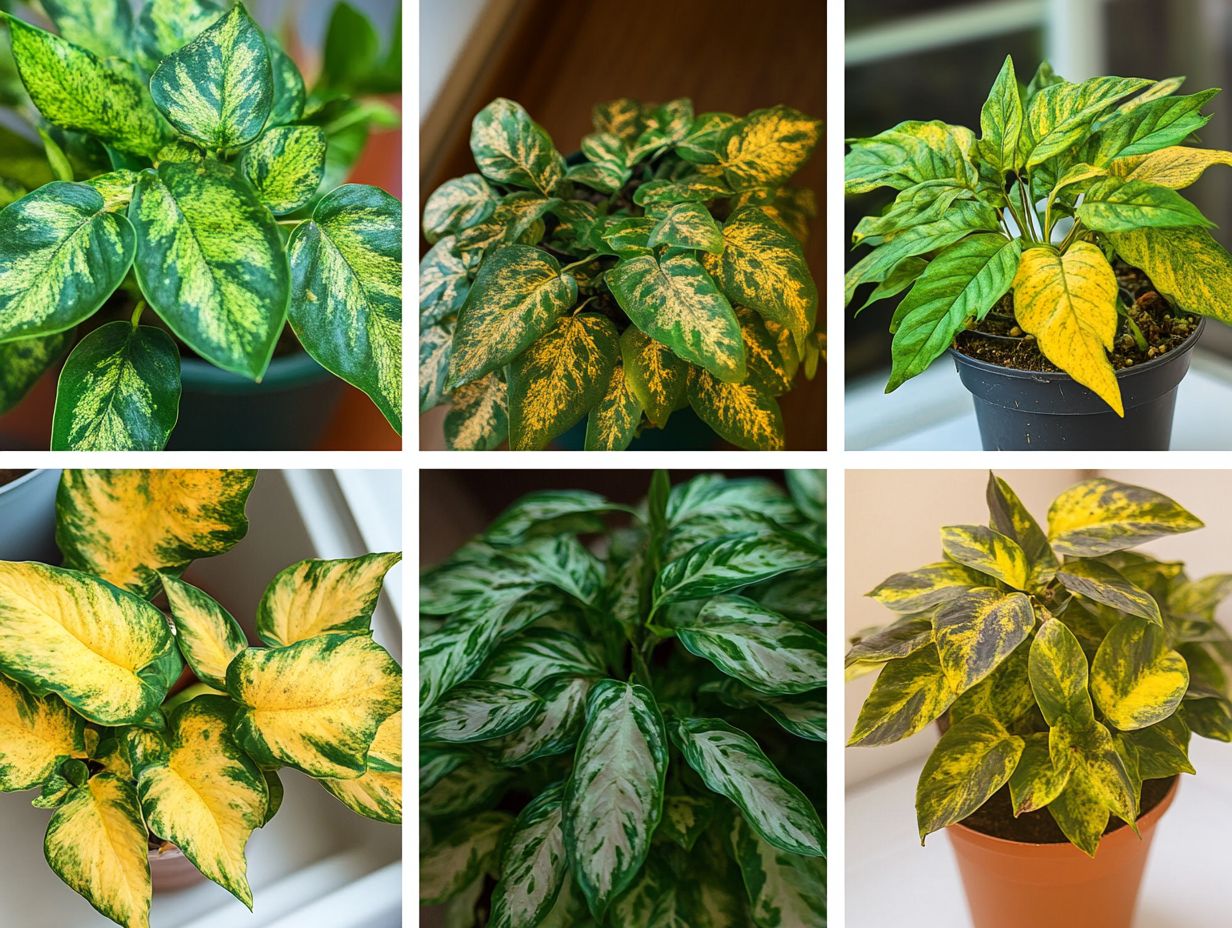
Symptoms of indoor plant diseases can appear in several distinct ways. Look for yellowing leaves, distorted growth, and leaf drop these are telling signs that something is amiss, whether due to pests or environmental stress.
These symptoms can vary greatly depending on the specific issue at hand. For instance, dark spots on the leaves might indicate that your plant is grappling with a fungal infection, which is caused by tiny organisms that harm plant health. A white, powdery residue could signal powdery mildew, a common plant ailment. To protect your plants from such issues, be aware of the top 5 most destructive indoor plant pests. Wilting leaves combined with a mushy stem often suggest root rot, typically stemming from overwatering.
By identifying these visual cues early, you empower yourself to take swift action. This may include adjusting your watering routine, improving air circulation, or applying the right treatments. For example, incorporating the top 5 tropical plants for indoor environments can enhance your space. Consistent monitoring and maintaining optimal growing conditions create a healthier environment, enabling you to prevent many diseases before they even have a chance to take root.
How Can These Diseases Be Treated?
Treating indoor plant diseases effectively demands a thoughtful approach. You can utilize methods such as applying neem oil for pest control and adjusting care regimens to enhance overall plant health, which leads to a proactive disease management strategy.
Understanding the specific needs of each plant species is vital, as different treatments are designed for various issues. For example, you may need to act quickly with chemical fungicides for severe fungal infections, while organic solutions like baking soda can help tackle mildew. If you’re considering adding greenery to your space, check out the top 5 indoor plants for home offices. Begin by accurately identifying the problem, then select the treatment option that fits best.
Once you’ve applied any solution, keep a close eye on your plant. Ensure you’re maintaining optimal lighting and watering conditions, as these factors can significantly influence recovery. For beginners, consider using the top 5 indoor plants that are easy to care for. Regular follow-ups will allow you to adjust your treatment strategies as needed, ultimately boosting your plant’s resilience against future diseases.
What Are the Most Susceptible Types of Indoor Plants?
Certain indoor plants can be particularly susceptible to diseases and pests. Common varieties like Ficus are especially vulnerable to issues such as root rot and powdery mildew. This highlights the importance of tailored care strategies to keep your plants thriving.
It’s essential to examine the environmental conditions in which your houseplants flourish. Factors like humidity, light exposure, and watering habits significantly influence their health and vulnerability. For instance, if you keep Spider Plants in overly dry conditions, you might find them attracting spider mites. To protect your plants, consider the top 5 pest control products for houseplants. Conversely, Peace Lilies can develop leaf spots if they aren’t watered correctly.
To tackle these challenges, adjust your watering schedules, ensure proper drainage, and create a humidity-friendly environment. Regular inspections for early signs of pests and diseases give you the power to act swiftly, and using natural remedies for houseplant pests can ensure that your verdant companions remain robust and flourishing.
How Can Indoor Plants Be Maintained to Prevent Disease?
Maintaining your indoor plants in optimal conditions is essential for preventing diseases. Closely monitor humidity levels, ensure they receive adequate light exposure, and follow best practices for plant care. Healthy plants are more resilient against common threats.
Establish a regular watering schedule and adjust it based on the specific needs of each plant. This way, you can avoid the pitfalls of overwatering or underwatering, which are major causes of plant stress. For those interested in choosing the right plants for your environment, consider the top 5 indoor plants for humid spaces. Keeping the foliage clean is also vital; gently wiping the leaves with a damp cloth not only removes dust but also helps you spot early signs of pests.
Creating a balanced environment means recognizing the importance of proper fertilization and using organic solutions to enhance soil quality. With these efforts, your green companions will thrive and significantly improve the air quality in your space.
Frequently Asked Questions
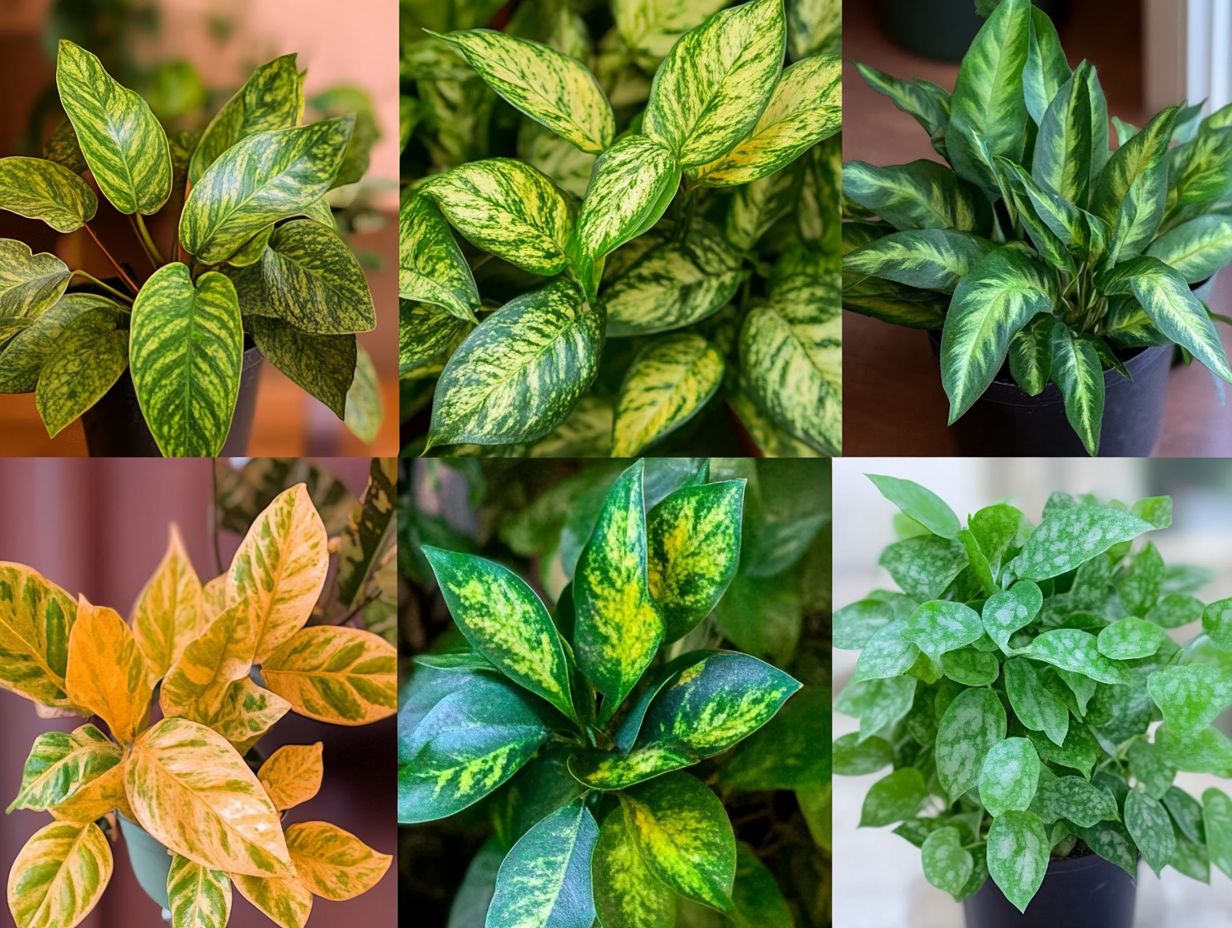
What are the top 5 indoor plant diseases to watch for?
Watch out for these top 5 indoor plant diseases: powdery mildew, root rot, leaf spot, spider mites, and fungal infections like gray mold.
How can I identify powdery mildew on my indoor plants?
Powdery mildew looks like a white or gray powder on the leaves and stems. It can cause leaves to curl and turn yellow, leading to bigger plant problems.
What causes root rot in indoor plants?
Overwatering is the main cause of root rot. This can lead to fungal growth in the soil, especially if the drainage is poor or if contaminated soil is used.
Can leaf spot spread to other plants?
Leaf spot is a fungal infection that spreads through water, wind, or contact. Isolate infected plants and treat them quickly to prevent spreading.
How do I get rid of spider mites on my indoor plants?
To eliminate spider mites, spray your plants with a mix of water and dish soap, or use insecticidal soap. Regularly wipe your plants with a damp cloth to remove any mites.
Are there any preventative measures I can take to avoid fungal infections on my indoor plants?
You can prevent fungal infections by watering correctly and ensuring your plants have good drainage and airflow. Using a fungicide can also help keep gray mold at bay.


